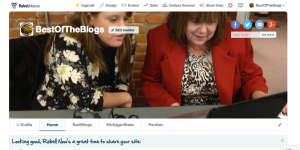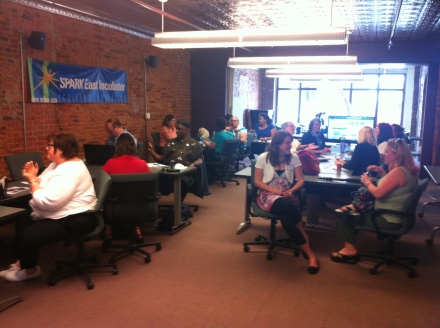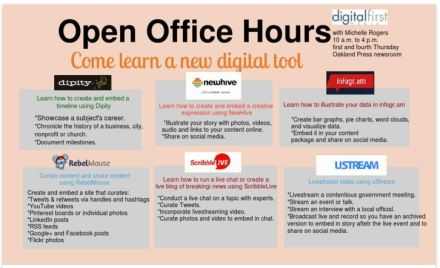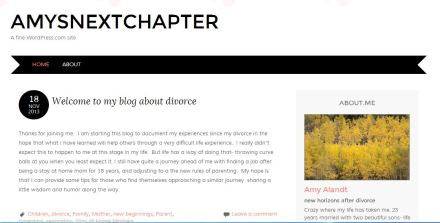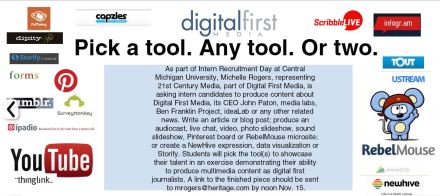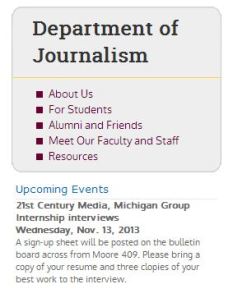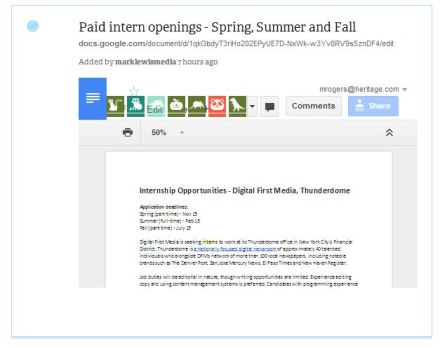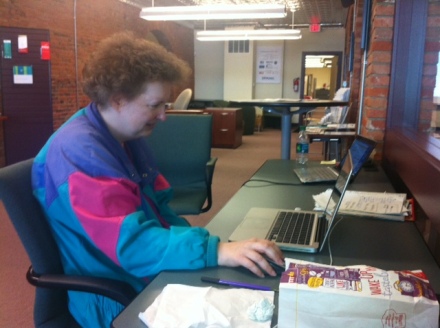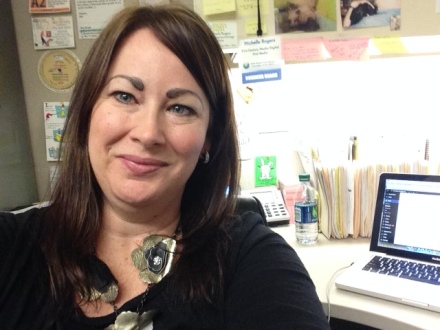
Michelle Rogers (that’s me), director of community engagement and editorial training for Digital First Media’s Michigan Group, runs the Southeast Michigan Media Lab in Ypsilanti.
Last week was a busy time at the Southeast Michigan Media Lab, and that’s what makes this job so much fun. When I make a number of commitments — sometimes more than I initially think I can deliver on — and then finish the week with everything completed and up to my standards, it feels so rewarding.
Among the highlights last week was presenting to Eastern Michigan University’s Public Relations Student Society of America chapter. I worked on my PowerPoint for the group Monday, cobbling together some slides I had used for a presentation to the Milan Area Chamber of Commerce with some other slides I shared with marketing students in Macomb County schools, as well as new slides appropriate for their needs.
Presentation 6 tonight for @emuPrssa at #emu student center to focus on @CommunityMediaL http://t.co/iGs2LgVjqB
— Michelle Rogers (@ideaLabHeritage) January 21, 2014
The presentation gave background information about the media lab, our free services and opportunities for public relations, marketing and journalism students, as well as a rundown of free digital tools they could use to hone their skills.
While it started out bumpy, as the bag containing my projector was missing a crucial cord to plug the projector into an electrical outlet and I had to run back to the office (luckily, I arrived early enough to have time to do this), it was a success in the end. When I asked students to raise their hands if they thought they would be visiting the media lab soon, everyone (I am pretty sure) raised their hands. In fact, a few approached me afterward and followed up through email with ideas for partnerships, including an Internet radio show on BlogTalk Radio and two blogs.
learning about the @ideaLabHeritage and @CommunityMediaL tonight in our #ePRmtg with @emuprssa!!
— emily vontom (@emilyvontom) January 21, 2014
Also on Tuesday, I was on a three-hour webinar with Digital First Media colleagues across the United States listening to Thomas W. Rhoads of Bucks County Community College’s Center for Workforce Development present the Innovation and Creativity Program. We weren’t even through the entire program and I was already emailing Claire Gavel, DFM’s chief learning officer, suggesting everyone in our organization go through the training. While it’s cost prohibitive, as Claire explained, she said they would be presenting it again and she would allow me to invite specific individuals who I thought could benefit from it the most.
During the training, I felt inspired and invigorated as we, as a group, were encouraged to innovate and lead. I felt empowered and wanted others I work with to feel the same, in whatever they do. Among my takeaways was Rhoads’ assertion that we should all be open to learning and growing as that’s what inspires innovation. Collaboration is and always will be important. As Rhoads puts it, innovative organizations collaborate. And don’t be afraid of being judged or hurt because that will stifle your own creativity.
Accountability was another big theme, as well as consistency, authenticity and having standards/values. It’s important to empower people by asking for their ideas. People share more if they believe you trust their ideas, Rhoads said. Also, don’t be afraid to fail. If something doesn’t work, you learn from it. If it works, you can count it as a success and then look at how you can improve upon it — always grow and learn.
Making a difference, staying engaged, offering encouragement, trusting and courageousness inspire people, so I have renewed my commitment to all of those approaches as I move forward with my work at DFM’s Michigan Group.
The next day offered another fun-packed day with a webinar on trends in online journalism offered by the Online News Association, a one-on-one session with a blogging partner,
Excited to jump on @ONA webinar at 11 ET "2014 Trends in Online Journalism." Love these learning opportunities. And best yet, it's free!
— Michelle Rogers (@ideaLabHeritage) January 22, 2014
a conference call with my new boss and a workshop for the public on contributing guest columns and letters to the editor.
What’s cool about my one-on-ones with bloggers is that I always learn something new, too, while trying to help them troubleshoot a problem or implement something I had never thought of doing. When I met with Linda Tubbs of Professional Volunteer Corps, we were adding a tab on her blog and sub-pages under the tab. In doing so, we learned together, through trial and error, how to do it by designating a post as a “child” under a “parent” page. We also played around with embedding her WordPress blog on the group’s WordPress website without totally moving it. While we searched online for advice and found some HTML code that should have accomplished exactly what we wanted, it didn’t work. So, WordPress may have changed something since the post was written. I came up with an alternative of setting up a RebelMouse page, embedding it on the website and running her blog’s RSS feed automatically through the RebelMouse page, but she didn’t like it because of the RebelMouse branding. So, I’ll continue to work on solving that dilemma.
Also Wednesday, while waiting for a conference call that ended up being canceled,
I created a RebelMouse page curating the RSS feeds of 25 of our best blogs and shared it on all of our sites to give an extra boost to our blogging partners. I plan to change the featured bloggers quarterly, so everyone gets the extra exposure.The workshop in the evening was a fun collaboration between me and reporter Andrew Kidd of The Oakland Press. Andrew had proposed about a month or so earlier that we travel around to our various newsrooms and teach our audience the basics of editorial writing. Andrew also serves as the opinion page editor of The Oakland Press, Macomb Daily and Daily Tribune, so he has been coming across a number of issues with unsigned letters, letters that lack focus and submissions containing sexist, racist and homophobic remarks. Using Google Presentations, we collaborated on a PowerPoint and spoke to our first group Wednesday at The News-Herald in Southgate and broadcast the session live using uStream. We had a small group of five, but we are hopeful we will have more interest this Wednesday from readers at The Oakland Press.
Thursday was another rewarding day as my help was totally embraced by staff at The Oakland Press when I put in my fourth day of office hours. Three earlier times, offered around the holidays, were not as fruitful — probably because of the holidays, shorter deadlines and smaller resources with staff on vacation. I was thrilled to walk in this time and have four people immediately set up times to meet with me. It really made my day, especially after the 2 1/2-hour commute in horrid driving conditions. From creating Valentine’s Day surveys in Google Forms with Lara Mossa Stump and setting up labs in Kathy Blake’s gmail to brainstorming Tout ideas and reviewing RebelMouse setup with Aftab Borka to experimenting with TweetPic with Carol Hopkins, helping my colleagues learn new tools
@OPCarolHopkins Success! Both show up in news stream. pic.twitter.com/1qbbZsWORA
— Michelle Rogers (@ideaLabHeritage) January 24, 2014
and overcome technology-related stumbling blocks really brings me great joy and a sense of accomplishment.
Friday was more social media postings and monitoring, the announcement and start to a social media revamp for our Michigan cluster, and a conference call with editorial trainers across our organization about a new Learning Management System we had been trained on a couple weeks ago called Desire2Learn. I am really excited about the potential of this new tool, and I will devote an entire blog post to it in the coming days. Basically, it will facilitate our training, allow us to work more efficiently and through collaboration, and run our own internal learning institute as reporters and sales representatives continue to learn, grow and evolve in this changing environment we work in.
Over the weekend, I wrapped up some loose ends I hadn’t attended to during the week, including starting a survey through SurveyMonkey for The News-Herald’s annual “And the winner is …” contest for the Academy Awards. Since it had been longer than six months since I used SurveyMonkey, I wanted to get in there before showing reporter Andrea Blum how to set up the survey for her audience. As soon as I started, I remembered how intuitive and easy to use the application is for laymen. Later today, I’ll walk Andrea through the process, as well as her boss, Managing Editor Rick Kessler, who will be developing a Reader Focus Group survey.
And, finally, the icing on the cake today came in an email from my new boss, Don Wyatt, vice president of news for DFM’s Michigan Group, who dubbed my suggested name for a new drop-down tab on our website for in-depth data-driven stories as the winner. After coming up with a long list of suggestions,  narrowing it down to a top 5, asking our readers to vote and/or give suggestions, and then deciding none fit the bill, I suggested DataWorks over the weekend and he liked it. Feeling as if your time is well spent, and your ideas and help are valued, really makes for the most awesome feeling at work. In fact, it makes it feel as if work is play, and that is what I strive for in life.
narrowing it down to a top 5, asking our readers to vote and/or give suggestions, and then deciding none fit the bill, I suggested DataWorks over the weekend and he liked it. Feeling as if your time is well spent, and your ideas and help are valued, really makes for the most awesome feeling at work. In fact, it makes it feel as if work is play, and that is what I strive for in life.

